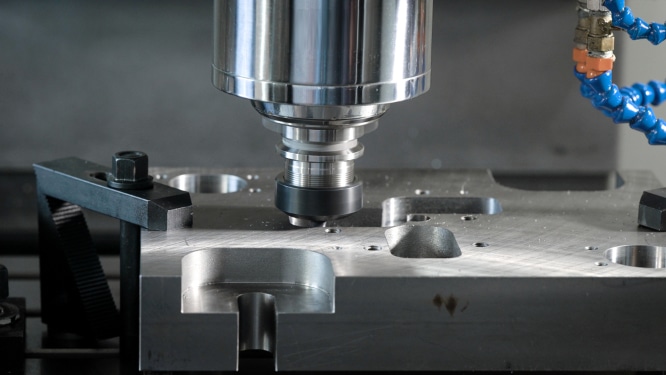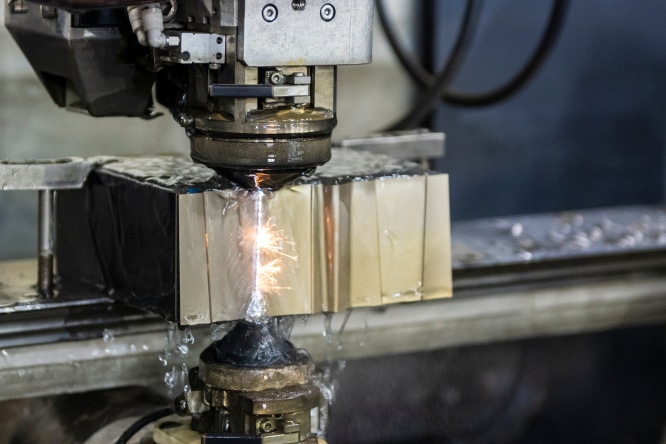EDM/Sinker EDM
EDM/Sinker EDM, also commonly referred to as “die sinking”, is a process in which electrical discharges are used to erode material from a workpiece. The process involves submerging the workpiece into an electrically conductive liquid and then connecting it to a power source. Once the power source is activated, electrical discharges occur between the electrode and the workpiece. As these electrical pulses are sent through the liquid medium between the two surfaces, it causes the material to be removed from the workpiece in tiny amounts. This machining method can produce parts with extreme accuracy and detail, often surpassing the precision levels achievable by other methods.
This method of machining is highly versatile and can be used on almost any type of metal – from aluminium alloys to hardened steels and titanium – and even some plastics. Furthermore, because this method uses non-contact erosion techniques, there is no need for high-cutting forces like those necessary for traditional milling or drilling operations. This results in minimal tool wear and reduced risk of component damage due to vibration or excessive heat generated during machining processes. This also means that EDM/Sinker EDM can produce intricate shapes and small holes with high precision.

Applications of sinker EDM
Sinker EDM is particularly well-suited for hard machining materials such as hardened steel, carbides, ceramics and other difficult-to-process metals. It can also be used for more complex geometries that require fine details and intricate shapes. The sinker EDM process is also often employed for producing dies, moulds, stamps and punches, which are needed in the production of various industrial products. These include mould cavities, deep grooves, detailed holes and even medical instruments with small internal passageways.
Wire EDM
Wire EDM is another form of Electrical Discharge Machining (EDM) that uses a wire instead of an electrode. This method utilises a thin wire, typically made from brass or copper alloys, suspended between two rotating spools to cut through and shape metal components to precise dimensions and tolerances. The wire is continuously fed under tension through the workpiece while a stream of electrolyte solution flushes away debris. Wire EDM is capable of producing slots, detailed internal curves, and complex three-dimensional shapes with excellent accuracy and repeatability – often surpassing the levels achievable by other methods such as milling or grinding. It can also be used on materials that are too hard or brittle for traditional machining processes, making it an ideal choice for producing dies and moulds with intricate geometries.
The difference between EDM and wire EDM is the lack of contact between the cutting tool and workpiece; this eliminates the risk of component damage due to vibration or excessive heat generated during machining processes. And since the cutting force is largely independent of material hardness – there’s no need to use a harder cutting tool – which makes this process more efficient in terms of time spent on production and material consumption. Furthermore, Wire EDM can also produce parts with superior surface finishes because no pressure is applied at any point during machining. This makes it ideal for applications that require parts with minimal burrs and roughness.

Applications of wire EDM
Wire EDM is commonly used in the manufacturing industry for a variety of applications. It is particularly useful for intricate contours and complex shapes that would otherwise be difficult to cut with traditional machining methods. In addition, it can handle very hard materials such as carbide and materials with different hardness levels. Wire EDM is also ideal for producing components with strict tolerance requirements and ultra-high precision. Common applications include the production of dies and moulds, turbine blades, medical instruments, and aerospace parts.
Sinker EDM vs Wire EDM
Similarities:
Differences:
Which one is Better EDM or Wire EDM
The selection of EDM or Wire EDM depends on the application and its requirements. When it comes to precision and accuracy, both processes are capable of producing parts with extremely high levels of detail. However, if the component requires a complex shape or intricate details, then Sinker EDM is typically more suitable than Wire EDM. On the other hand, if strict tolerance requirements and ultra-high precision are needed, then Wire EDM may be your best option. Ultimately, it is essential to consider all factors when choosing between the two processes to ensure that you select the one that best fits your needs and budget.
Overall, both EDM and wire-cut EDM offer powerful machining capabilities for precise results. They can both be used to cut any type of conductive material and produce components with high levels of accuracy. However, selecting one process over the other should be based on the application’s requirements, complexity, and desired results. By understanding the differences between EDM and wire EDM, businesses can make an informed decision on which process is best suited for their needs.
Based on your project's requirements, the Bellcliffe Engineering team can assist you not only in selecting the best application but also in the entire production process.
Read more ...